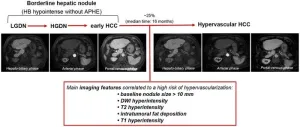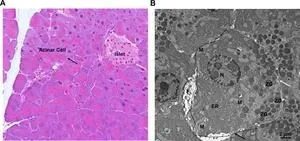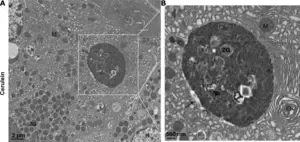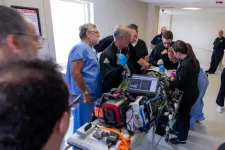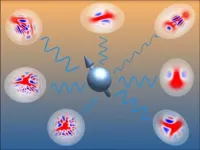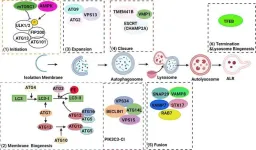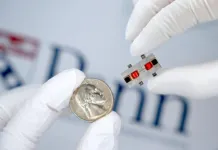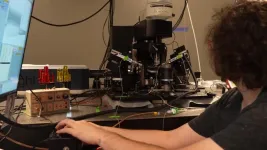(Press-News.org)
Hepatocellular carcinoma (HCC) represents a significant global health burden as one of the most common malignancies in individuals with chronic liver disease or cirrhosis. This malignancy evolves through a multistep process, beginning with dysplastic nodules (DNs) and early HCC, progressing to overt HCC. Recent advancements in liver imaging, particularly the use of hepatocyte-specific contrast agents, have enhanced the detection of these precursor lesions, known as borderline hepatic nodules. These nodules, especially those hypointense in the hepatobiliary phase (HBP) without arterial phase hyperenhancement (APHE), present a diagnostic challenge and a significant risk of malignant transformation.
The use of liver-specific contrast agents, such as gadoxetic acid, in magnetic resonance imaging (MRI) has revolutionized the detection and characterization of hepatic nodules. In the HBP, these agents highlight the lack of functioning hepatocytes in malignant or pre-malignant nodules, which appear hypointense against the background of normal liver parenchyma. This imaging technique has improved the diagnostic accuracy for small HCC lesions (<2 cm) and reduced recurrence rates, enhancing overall patient prognosis.
Moreover, the integration of diffusion-weighted imaging (DWI) with gadoxetic acid-enhanced MRI has further increased the specificity and sensitivity in identifying HCC, even for nodules smaller than 1 cm. This combination helps distinguish true HCC from benign hypervascular pseudolesions, which is crucial for appropriate clinical management.
Borderline hepatic nodules encompass a spectrum of lesions, including DNs and early HCCs. Pathologically, these nodules exhibit varying degrees of cytological and architectural atypia. High-grade dysplastic nodules (HGDNs) and early HCCs often display unpaired arteries and intermediate sinusoidal capillarization, but lack significant vascular invasion, making them difficult to distinguish from low-grade dysplastic nodules (LGDNs) on imaging alone.
The expression of organic anion-transporting polypeptide 8 (OATP8) is notably reduced in these nodules, leading to their characteristic hypointensity in the HBP on MRI. This reduction in OATP8 expression occurs early in hepatocarcinogenesis, prior to the development of the vascular changes typical of overt HCC.
The detection of HBP hypointense nodules without APHE has significant clinical implications. Studies have shown that the initial size of these nodules is a strong predictor of malignant transformation. Nodules larger than 10 mm at initial detection have a higher risk of progression to hypervascular HCC. This risk necessitates a vigilant and tailored follow-up strategy for patients with such nodules.
However, there is a lack of consensus on the management of these nodules. The variability in study populations and follow-up periods has led to inconsistent findings regarding the risk factors and natural history of these lesions. Some studies suggest that antiviral therapies, such as direct-acting antivirals (DAAs) for hepatitis C, may reduce the rate of hypervascular transformation, although this remains a topic of ongoing research.
In conclusion, the detection and management of borderline hepatic nodules, particularly those hypointense in the HBP without APHE, are critical in preventing the progression to overt HCC. Advances in imaging technologies, specifically the use of liver-specific contrast agents and DWI, have significantly improved our ability to detect and characterize these nodules. Understanding the pathological features and natural history of these lesions is essential for developing standardized guidelines for their management. Further research is needed to refine these strategies and optimize patient outcomes.
This review highlights the current state of knowledge regarding borderline hepatic nodules, emphasizing the importance of early detection and individualized patient management to mitigate the risk of HCC development.
Full text
https://www.xiahepublishing.com/2310-8819/JCTH-2023-00130
The study was recently published in the Journal of Clinical and Translational Hepatology.
The Journal of Clinical and Translational Hepatology (JCTH) is owned by the Second Affiliated Hospital of Chongqing Medical University and published by XIA & HE Publishing Inc. JCTH publishes high quality, peer reviewed studies in the translational and clinical human health sciences of liver diseases. JCTH has established high standards for publication of original research, which are characterized by a study’s novelty, quality, and ethical conduct in the scientific process as well as in the communication of the research findings. Each issue includes articles by leading authorities on topics in hepatology that are germane to the most current challenges in the field. Special features include reports on the latest advances in drug development and technology that are relevant to liver diseases. Regular features of JCTH also include editorials, correspondences and invited commentaries on rapidly progressing areas in hepatology. All articles published by JCTH, both solicited and unsolicited, must pass our rigorous peer review process.
Follow us on X: @xiahepublishing
Follow us on LinkedIn: Xia & He Publishing Inc.
END
Nonalcoholic fatty liver disease (NAFLD) has become the most prevalent chronic liver condition worldwide, affecting about 25% of the global population due to the increasing rates of obesity and metabolic syndrome. NAFLD encompasses a spectrum of liver conditions ranging from simple hepatic steatosis to nonalcoholic steatohepatitis (NASH), which can progress to fibrosis, cirrhosis, and hepatocellular carcinoma (HCC). Despite its prevalence, there are limited effective treatment options available. Inflammation driven by metabolic disturbances is a key factor in the development and progression of ...
For the first time, a closed loop, autonomous intervention nearly quadrupled the “golden hour” during which surgeons could save the life of a large animal with internal traumatic bleeding while in emergency ground and air transport.
This breakthrough in trauma care, announced today in Intensive Care Medicine Experimental by physician-scientists at the University of Pittsburgh School of Medicine and funded by the U.S. Department of Defense, has enormous potential for saving the lives of traumatically injured ...
Many of today’s quantum devices rely on collections of qubits, also called spins. These quantum bits have only two energy levels, the ‘0’ and the ‘1’. However, spins in real devices also interact with light and vibrations known as bosons, greatly complicating calculations. In a new publication in Physical Review Letters, researchers in Amsterdam demonstrate a way to describe spin-boson systems and use this to efficiently configure quantum devices in a desired state.
Quantum devices use the quirky behaviour of quantum ...
Singapore, 24 May 2024 – Two multi-institution and multidisciplinary Singapore teams of clinician-scientists and researchers have been awarded grants of S$25 million each, by the Singapore Ministry of Health through the NMRC Office, MOH Holdings Pte Ltd, under the NMRC Open Fund-Large Collaborative Grant (OF-LCG) programme. The S$50 million support for cancer research establishes the SYMPHONY 2.0 and Colo-SCRIPT research programmes to drive precision oncology research in Singapore aimed at improving the understanding, diagnosis and treatment of lymphoma and colorectal cancer.
Led by the ...
Researchers are exploring a new potential avenue for pancreatitis treatment: autophagy, a cellular recycling process. Autophagy helps maintain healthy pancreatic acinar cells by removing damaged organelles like mitochondria and the endoplasmic reticulum (ER).
A new review published in eGastroenterology highlights the link between defective autophagy and pancreatitis. Impaired autophagy contributes to pancreatitis by allowing damaged organelles to accumulate within acinar cells. This accumulation disrupts cellular function and can ultimately lead to cell death.
"Autophagy plays a vital role in keeping pancreatic acinar cells healthy," ...
In the early 2010s, LightSquared, a multibillion-dollar startup promising to revolutionize cellular communications, declared bankruptcy. The company couldn’t figure out how to prevent its signals from interfering with those of GPS systems.
Now, Penn Engineers have developed a new tool that could prevent such problems from ever happening again: an adjustable filter that can successfully prevent interference, even in higher-frequency bands of the electromagnetic spectrum.
“I ...
TAMPA, Fla. (May 24, 2024) – Through high-tech imaging and virtual reality, a University of South Florida medical engineering professor is creating a detailed map of the brain that can be used to better understand developmental disorders, such as autism, and provide earlier, more effective treatments for brain injuries and diseases.
Funded by a $3.3 million grant from the National Institutes of Health, George Spirou is expanding on his four decades of brain research to focus on the part of the brain that ...
Semaglutide significantly reduces risk of major kidney disease events, cardiovascular outcomes and mortality in patients with type 2 diabetes and chronic kidney disease, groundbreaking study reveals
A pioneering study has demonstrated that semaglutide significantly reduces the risk of major kidney disease events, cardiovascular outcomes, and all-cause mortality in patients with type 2 diabetes and chronic kidney disease.1 The landmark trial, presented today at the 61st ERA Congress, will pave the way for new treatment strategies and ...
Enhancing drug development for life-threatening diseases like cancer hinges on a deep understanding of protein kinases, making it a focal point for researchers. These enzymes, encoded by more than 500 human genes, serve as critical players in cellular signaling pathways. However, if these signals are dysregulated, they can disrupt the normal cellular mechanisms, leading to diseases such as cancer. Protein kinase inhibitors have therefore provided a promising avenue in therapeutic intervention to disrupt the aberrant signaling ...
In recent years, global environmental concerns have prompted a shift toward eco-friendly manufacturing in the field of organic synthetic chemistry. In this regard, research into photoredox catalytic reactions, which use light to initiate redox or reduction-oxidation reactions via a photoredox catalyst, has gained significant attention. This approach reduces the reliance on harsh and toxic reagents and uses visible light, a clean energy source.
A key research area has been the development of recycling methods for photocatalysts, which offer both economic and environmental benefits. Photocatalysts use light to accelerate a chemical reaction without getting consumed in the process, and photoredox ...
